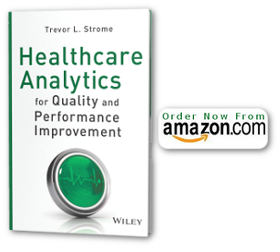There is no doubt that executive or strategic dashboards can be considered the “sexy” healthcare Business Intelligence (BI) application of today (that is, until predictive analytics tools begin to proliferate). In fact, many posts on this website will be dedicated to ensuring that analytic applications help communicate and track progress on organizational strategies. Well deployed tactical uses of BI and analytics, however, can significantly improve how well organizations can meet strategic goals.
Strategic uses of healthcare BI tools such as executive dashboards and other applications that present strategic-level data only begin to scratch the surface of the potential uses of analytics and the capabilities of analytics toolsets. There is, however, the opportunity for huge growth in the use of analytics at the tactical level due to a number of factors:
- User-base: More non-traditional professionals (i.e., industrial engineers) very comfortable using analytics tools are being employed in healthcare for process and quality improvement.
- Data availability: The proliferation of healthcare information systems that provide data at increasing levels of detail allow for more insight into individual workflows and processes.
- Data Need: Healthcare Organizations (HCOs) are increasingly using methodologies like Lean and Six Sigma which rely on data to both help identify problems and to evaluate outcomes
Real performance improvement in HCOs is difficult without detailed, accurate, and timely data, without appropriate implementation and evaluation methodologies, and without quality specialists who can utilize analytics and apply the resultant insights. Healthcare quality specialists require detailed data based on metrics relevant to the processes being changed and evaluated.
Healthcare quality specialists often rely on frequent performance audits and detailed performance data to coach staff on changes to processes. The sooner issues can be spotted and brought to the attention of process owners, the easier it is to provide coaching and to manage overall process performance. It is this rapid turn-around of detailed process performance data that enables coaching and other change-management activities to be effective.
Much of the work I have been doing has been to enable analytics at the tactical level. For example, I have been involved in Lean transformation projects focusing on certain areas of Emergency Department performance where data was extracted and reported on daily based on metrics desired by the transformation team. These daily metrics were provided to the process owners to evaluate the impact of process changes. Having this data available allowed process modifications to be made, if necessary, and to determine if performance was approaching (and maintaining) desired levels.
Strategic and tactical analytic applications will continue to see greatly increased use throughout healthcare. HCO leaders will continue to need strategic analytics to help communicate strategy throughout an organization and to monitor the organization’s progress toward achieving desired performance and goals. To complement this, the growing availability of tactical-level analytics will be crucial to enable processes, workflows, and ultimately quality, to be optimized and lead to the performance levels desired by the HCO.

{ 0 comments… add one now }